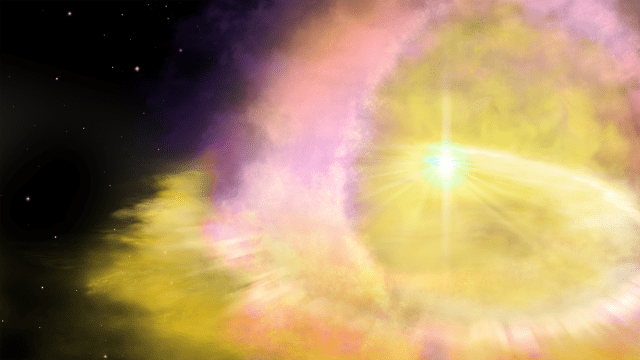Back in 2016, a telescope spotted a supernova flaring so brightly that it far outshone its own galaxy. The exploded star continued emitting radiation for more than 1,000 days, unleashing more energy than any supernova previously documented. But that’s only the start of the story.
The supernova, named SN2016aps, was unlike any supernova on record, lasting for so long that postdocs became professors while still studying it. Not only was it a big show, but it was also a massive one, with five to 10 times the mass of a typical supernova. It was one of the largest stars ever seen to explode. Researchers hope it will help them understand some of the universe’s early epochs.
“A very massive star like this might be more common in the very early universe,” Matt Nicholl, the study’s first author form the University of Birmingham in the United Kingdom, told Gizmodo. “We might be able to use this data to peer back in time to see the explosions of some of the very first stars.”
[referenced url=” thumb=” title=” excerpt=”]
When the Panoramic Survey Telescope and Rapid Response System spotted the flash on February 22, 2016, it quickly caught the attention of scientists studying supernovae. A team led by Edo Berger at the Harvard & Smithsonian Centre for Astrophysics was interested in the most exotic supernovae they could find—the needles in the haystacks, Berger told Gizmodo. A closer look into SN2016aps revealed that a sky survey called the Intermediate Palomar Transient Factory had first revealed brightening in the galaxy beginning in December 2015. The team continued collecting data with a host of telescopes around the world for over two years, as the supernova continued to emit optical and ultraviolet light.
The maximum brightness alone was notable, but the long span over which it emitted radiation was particularly exciting. Nicholl explained that when they summed up the total amount of radiated energy, it was the most light emitted by any supernova on record.
The wavelengths of light emitted by the object indicate that it exploded into a dense cloud of hydrogen gas, causing the bright flash. Calculations demonstrated that the total mass of the object plus the material it ejected before exploding could have exceeded 50 to 100 times the mass of the Sun. While difficult to prove, this star might be an example of a “pair instability” supernova, where the core of a really massive star collapses, leading to a runaway nuclear reaction that blows the star apart without leaving anything behind, according to the paper published today in Nature Astronomy.
But this event is weird for lots of other reasons. Such a massive star shouldn’t have ejected as much hydrogen as the team observed; Nicholl speculated that perhaps two smaller stars merged to create the final, more massive object. It’s not necessarily probable, but it’s perhaps plausible.
Merely witnessing a spectacle like this was thrilling. Now that researchers have seen such an event occurring around 10 billion years after the Big Bang, they hope that newer, more powerful telescopes like the James Webb Space Telescope and the Large Synoptic Survey Telescope will allow them to see similar events even further back in time, where they’re thought to be more common, Berger told Gizmodo.
“We’re not going to be happy with just one,” he said.
